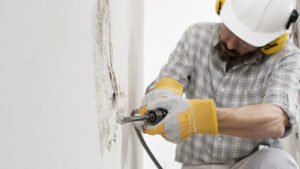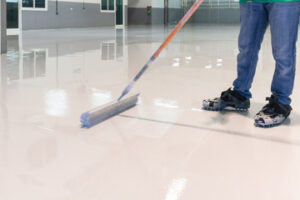Stucco Remediation Philadelphia involves removing damaged sheathing, framing, and insulation, as well as replacing it. This process is generally recommended when moisture damage is severe, such as cracking and staining or water leaks around doors and windows.

Leaking interiors are a good sign that stucco is in danger of failure. This is because they indicate that there’s trapped moisture behind the siding.
Stucco remediation is an expensive undertaking. However, it is worth the money when you consider what a complete repair will prevent in the future. If you don’t fix cracks or other issues as soon as they appear, moisture will continue to creep behind your stucco and can lead to rotting of the framing of your home and toxic black mold. This can be very costly and is not something that you want to have happen to your forever home.
In order to determine whether your stucco needs to be repaired or remediated, a qualified specialist will first conduct a visual inspection of the affected area. Moisture meter readings will also be taken to determine the level of moisture in the wall cavities. This will help the professional identify the underlying problem and recommend a course of action. The costs associated with a stucco remediation project will vary depending on the extent of the damage and the size of your home.
Typically, the more extensive the underlying damage, the more time and materials will be required to perform the repairs. The repair process usually begins with stripping away the existing stucco. This allows the professionals to access the sheathing, rotted framing and rotting insulation that needs to be replaced. In addition, they can repair any internal sources of damage that are not visible from the outside of your house.
In addition to the cost of stucco remediation, you will also need to consider additional expenses such as demolition, cleaning, and disposal of debris. You should also expect to pay for new weather barriers and flashing as well as paint, staining, and application tools. Lastly, there are also labor costs that may be involved, especially if the stucco repairs are located high up on your home. This may require the use of ladders or scaffolding to reach the damaged areas, so you should have this in mind when budgeting for your project. In addition, you should check with your homeowner’s insurance provider to see if the remediation costs are covered by your policy. Some will and some won’t, but it’s always worth a call to find out.
Time
A stucco remediation project requires a significant amount of time to complete. The length of time depends on the extent and severity of the damage and how much work is required to repair it. The cost of the project also varies depending on the scope of the repairs needed. For example, if the stucco has extensive mold damage, the price tag will be higher than if the issue is limited to surface cracks.
When a homeowner hires a contractor for stucco remediation, the first step is to perform a thorough inspection of the house, including a moisture test. This allows the contractor to determine if there are underlying issues that require remediation. Moisture intrusion is commonly found around windows, so the contractor usually starts with this area. Once they find evidence of moisture, they will remove the stucco layers and determine the cause.
The next step is to prepare the damaged areas for the restoration process. This involves protecting surrounding areas with plastic sheeting and removing old stucco layers. The contractor will then apply new materials, such as a waterproof membrane and new stucco. Afterwards, the contractor will inspect the walls for any signs of moisture intrusion and address the underlying problems.
If left untreated, moisture damage can lead to a host of issues, including mildew and mold growth, unsightly discoloration on the exterior, and wall rot. In severe cases, it can even result in the rotting of wooden components within your home. This can lead to structural damage and can significantly lower your home’s value.
Some homeowners might be able to avoid this problem by taking preventive measures. Regular inspections of the stucco and the surrounding area can help identify early signs of moisture damage, such as black stains or a musty smell. It is also important to maintain proper caulking and gutter systems to prevent water intrusion.
Homeowners that require stucco remediation can take steps to keep costs down, such as securing a home improvement loan with competitive interest rates or checking their homeowner’s insurance coverage to see if the damage is covered. However, it’s crucial to hire a qualified and experienced contractor, as the longer you wait to have this job done, the more costly it will be.
Environment
Stucco is a beautiful material that enhances the exterior of homes and buildings. However, it can also conceal problems that can threaten the structural integrity of a structure and lead to costly repairs or replacements. Fortunately, stucco remediation can prevent these issues and protect the health and safety of families.
Moisture is one of the most dangerous things that can affect a stucco exterior. It can cause rotting of the wooden beams that support the walls and other portions of a building. Water damage can also swell the grout, causing cracks that allow in mold and other contaminants. The best way to protect your stucco is to keep an eye out for any signs of moisture damage and to call in a professional as soon as possible.
In addition to the visual inspections, a stucco specialist should perform invasive and non-invasive moisture tests on the stucco of your home or business. This will help them identify any areas where the stucco is in need of repair or replacement. They can then recommend the correct course of action to remedy these issues.
Another sign that you need to get a stucco expert out to your property is when the interior of your house or business begins to leak. This may be caused by damaged plumbing or by trapped moisture behind the stucco. Leaking is unsightly, and it can lead to mold growth or cause water damage in other parts of your home or business.
Aside from leaking, stucco damage can also contribute to increased utility bills. This is because a damaged stucco will reduce the insulation of a home, leading to higher energy consumption for heating and cooling. This can also strain HVAC systems and result in premature wear and tear on their parts.
Stucco application and repair produce a lot of waste materials that must be disposed of properly. Improper disposal can contribute to landfill pollution and ecosystem degradation. A reputable stucco contractor will prioritize environmental stewardship by properly segregating materials on-site and partnering with recycling facilities to process leftover components. They will also promote sustainable construction by incorporating green technologies into their work and providing educational resources for their clients and staff.
Safety
When it comes to stucco repair or remediation, there are many things that must be taken into consideration. One of the most important is safety, as the process involves stripping layers of a wall and may involve dangerous equipment like saws or drills. This is why it is essential to have a professional take on the job.
Stucco inspections typically begin with a visual check of the walls. Inspectors will look closely at areas around windows and other spots where moisture could seep into the house. They will also check for signs of mold and rot, as these can be serious problems that threaten the integrity of your home’s structure.
Moisture staining is another common sign of impending stucco failure. This can appear as white, hazy streaks or dark blotches on the exterior of your house. If left untreated, it can lead to rotting wood and nasty black mold that poses a health risk for your family. In addition, if the mold penetrates the sheathing and framing of your house, it can cause other structural issues.
In addition to moisture, other factors that can damage stucco include improper installation and fading from sunlight. Stucco needs to be installed properly in order to last, and proper installation includes ensuring that the material is given enough time to dry between coats. If not, moisture can wreak havoc on your home’s structure and create problems that require costly remediation.
The main benefit of remediation is that it solves the underlying problems that are causing moisture to penetrate the stucco. This is a permanent fix that will not come back, unlike repairs that only treat the symptoms and not the problem itself.
While repairing stucco can be an effective solution in some cases, remediation is the only way to ensure that the issue is solved. A full remediation process will strip the stucco down to the base layer and then restore it using modern materials to create a lasting solution. This will not only make your stucco look better, but it will also protect the interior of your home from moisture damage and prevent mold and rot from forming.

